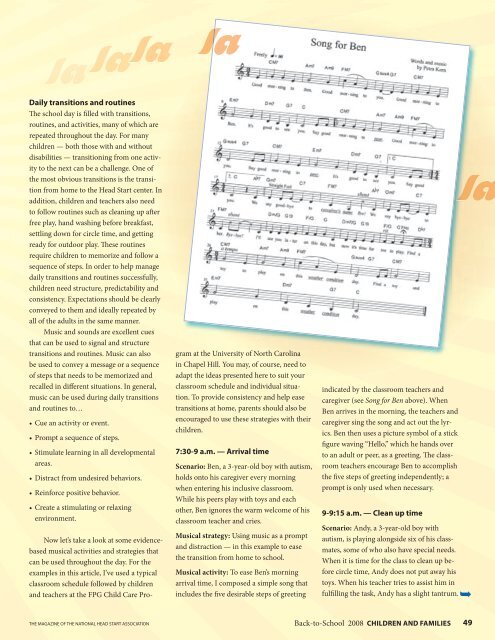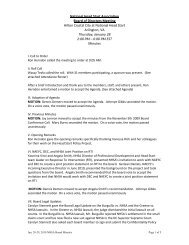New! - National Head Start Association
New! - National Head Start Association
New! - National Head Start Association
You also want an ePaper? Increase the reach of your titles
YUMPU automatically turns print PDFs into web optimized ePapers that Google loves.
Daily transitions and routines<br />
e school day is lled with transitions,<br />
routines, and activities, many of which are<br />
repeated throughout the day. For many<br />
children — both those with and without<br />
disabilities — transitioning from one activity<br />
to the next can be a challenge. One of<br />
the most obvious transitions is the transition<br />
from home to the <strong>Head</strong> <strong>Start</strong> center. In<br />
addition, children and teachers also need<br />
to follow routines such as cleaning up a er<br />
free play, hand washing before breakfast,<br />
settling down for circle time, and getting<br />
ready for outdoor play. ese routines<br />
require children to memorize and follow a<br />
sequence of steps. In order to help manage<br />
daily transitions and routines successfully,<br />
children need structure, predictability and<br />
consistency. Expectations should be clearly<br />
conveyed to them and ideally repeated by<br />
all of the adults in the same manner.<br />
Music and sounds are excellent cues<br />
that can be used to signal and structure<br />
transitions and routines. Music can also<br />
be used to convey a message or a sequence<br />
of steps that needs to be memorized and<br />
recalled in di erent situations. In general,<br />
music can be used during daily transitions<br />
and routines to…<br />
• Cue an activity or event.<br />
• Prompt a sequence of steps.<br />
• Stimulate learning in all developmental<br />
areas.<br />
• Distract from undesired behaviors.<br />
• Reinforce positive behavior.<br />
• Create a stimulating or relaxing<br />
environment.<br />
Now let’s take a look at some evidencebased<br />
musical activities and strategies that<br />
can be used throughout the day. For the<br />
examples in this article, I’ve used a typical<br />
classroom schedule followed by children<br />
and teachers at the FPG Child Care Pro-<br />
gram at the University of North Carolina<br />
in Chapel Hill. You may, of course, need to<br />
adapt the ideas presented here to suit your<br />
classroom schedule and individual situation.<br />
To provide consistency and help ease<br />
transitions at home, parents should also be<br />
encouraged to use these strategies with their<br />
children.<br />
7:30-9 a.m. — Arrival time<br />
Scenario: Ben, a 3-year-old boy with autism,<br />
holds onto his caregiver every morning<br />
when entering his inclusive classroom.<br />
While his peers play with toys and each<br />
other, Ben ignores the warm welcome of his<br />
classroom teacher and cries.<br />
Musical strategy: Using music as a prompt<br />
and distraction — in this example to ease<br />
the transition from home to school.<br />
Musical activity: To ease Ben’s morning<br />
arrival time, I composed a simple song that<br />
includes the ve desirable steps of greeting<br />
indicated by the classroom teachers and<br />
caregiver (see Song for Ben above). When<br />
Ben arrives in the morning, the teachers and<br />
caregiver sing the song and act out the lyrics.<br />
Ben then uses a picture symbol of a stick<br />
gure waving “Hello,” which he hands over<br />
to an adult or peer, as a greeting. e classroom<br />
teachers encourage Ben to accomplish<br />
the ve steps of greeting independently; a<br />
prompt is only used when necessary.<br />
9-9:15 a.m. — Clean up time<br />
Scenario: Andy, a 3-year-old boy with<br />
autism, is playing alongside six of his classmates,<br />
some of who also have special needs.<br />
When it is time for the class to clean up before<br />
circle time, Andy does not put away his<br />
toys. When his teacher tries to assist him in<br />
ful lling the task, Andy has a slight tantrum.<br />
Back-to-School 2008 CHILDREN AND FAMILIES<br />
THE MAGAZINE OF THE NATIONAL HEAD START ASSOCIATION 49




